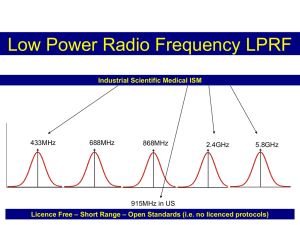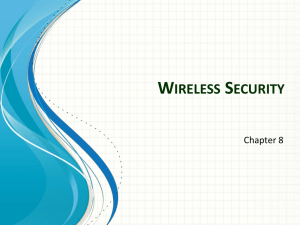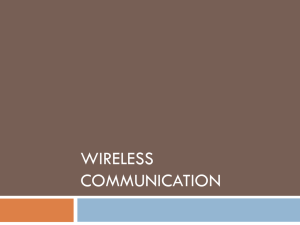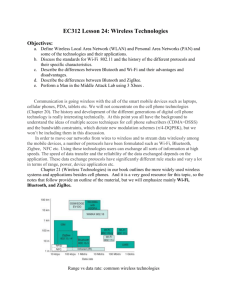2 VYAS & Pandya _Wireless Communication [ pp 5
advertisement
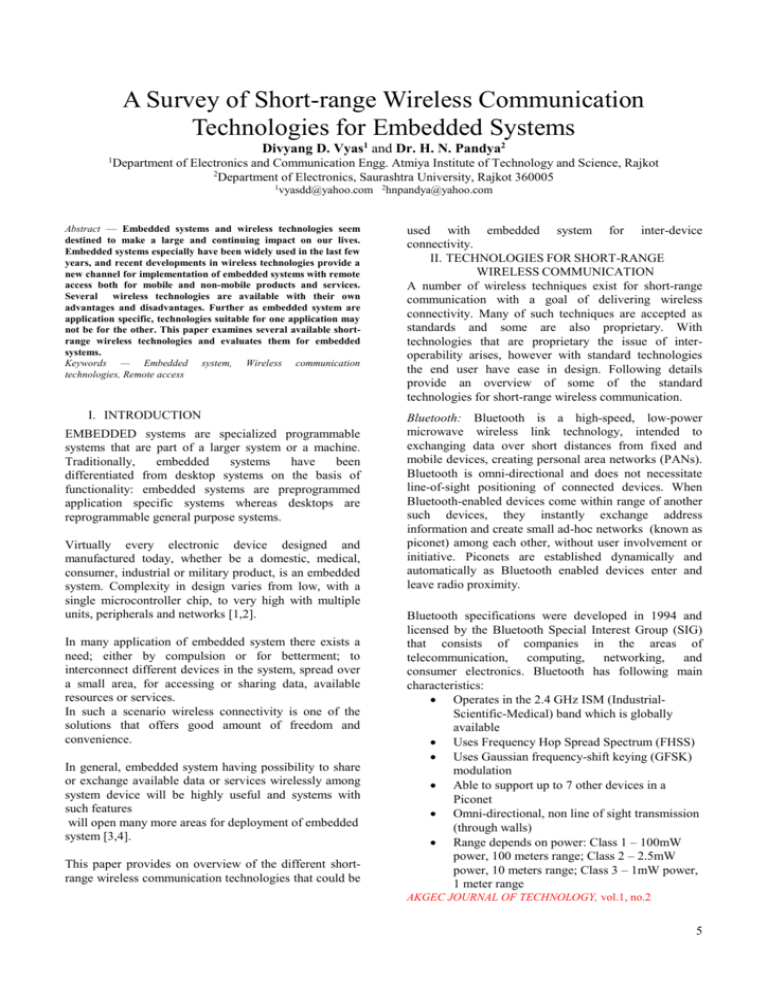
A Survey of Short-range Wireless Communication Technologies for Embedded Systems Divyang D. Vyas1 and Dr. H. N. Pandya2 1 Department of Electronics and Communication Engg. Atmiya Institute of Technology and Science, Rajkot 2 Department of Electronics, Saurashtra University, Rajkot 360005 1vyasdd@yahoo.com Abstract — Embedded systems and wireless technologies seem destined to make a large and continuing impact on our lives. Embedded systems especially have been widely used in the last few years, and recent developments in wireless technologies provide a new channel for implementation of embedded systems with remote access both for mobile and non-mobile products and services. Several wireless technologies are available with their own advantages and disadvantages. Further as embedded system are application specific, technologies suitable for one application may not be for the other. This paper examines several available shortrange wireless technologies and evaluates them for embedded systems. Keywords — Embedded system, Wireless communication technologies, Remote access I. INTRODUCTION EMBEDDED systems are specialized programmable systems that are part of a larger system or a machine. Traditionally, embedded systems have been differentiated from desktop systems on the basis of functionality: embedded systems are preprogrammed application specific systems whereas desktops are reprogrammable general purpose systems. Virtually every electronic device designed and manufactured today, whether be a domestic, medical, consumer, industrial or military product, is an embedded system. Complexity in design varies from low, with a single microcontroller chip, to very high with multiple units, peripherals and networks [1,2]. In many application of embedded system there exists a need; either by compulsion or for betterment; to interconnect different devices in the system, spread over a small area, for accessing or sharing data, available resources or services. In such a scenario wireless connectivity is one of the solutions that offers good amount of freedom and convenience. In general, embedded system having possibility to share or exchange available data or services wirelessly among system device will be highly useful and systems with such features will open many more areas for deployment of embedded system [3,4]. This paper provides on overview of the different shortrange wireless communication technologies that could be 2hnpandya@yahoo.com used with embedded system for inter-device connectivity. II. TECHNOLOGIES FOR SHORT-RANGE WIRELESS COMMUNICATION A number of wireless techniques exist for short-range communication with a goal of delivering wireless connectivity. Many of such techniques are accepted as standards and some are also proprietary. With technologies that are proprietary the issue of interoperability arises, however with standard technologies the end user have ease in design. Following details provide an overview of some of the standard technologies for short-range wireless communication. Bluetooth: Bluetooth is a high-speed, low-power microwave wireless link technology, intended to exchanging data over short distances from fixed and mobile devices, creating personal area networks (PANs). Bluetooth is omni-directional and does not necessitate line-of-sight positioning of connected devices. When Bluetooth-enabled devices come within range of another such devices, they instantly exchange address information and create small ad-hoc networks (known as piconet) among each other, without user involvement or initiative. Piconets are established dynamically and automatically as Bluetooth enabled devices enter and leave radio proximity. Bluetooth specifications were developed in 1994 and licensed by the Bluetooth Special Interest Group (SIG) that consists of companies in the areas of telecommunication, computing, networking, and consumer electronics. Bluetooth has following main characteristics: Operates in the 2.4 GHz ISM (IndustrialScientific-Medical) band which is globally available Uses Frequency Hop Spread Spectrum (FHSS) Uses Gaussian frequency-shift keying (GFSK) modulation Able to support up to 7 other devices in a Piconet Omni-directional, non line of sight transmission (through walls) Range depends on power: Class 1 – 100mW power, 100 meters range; Class 2 – 2.5mW power, 10 meters range; Class 3 – 1mW power, 1 meter range AKGEC JOURNAL OF TECHNOLOGY, vol.1, no.2 5 Low cost and chip sets for implementing Bluetooth are readily available Different data rates as per version: Version 1.2 Up to 1 Mbps; Version 2.0 + EDR - Up to 3 Mbps; Version 3.0 + HS - Up to 24 Mbps ISM band, which the Bluetooth uses, is potentially noisy part of the spectrum; however, the Bluetooth standard has been designed to work smoothly in this noisy, unregulated environment. A fundamental strength of Bluetooth wireless technology is the ability to simultaneously handle both data and voice transmissions. However, because Bluetoothenabled devices can potentially communicate with so many devices at once and without knowledge of the listener and its intent, data security becomes an important consideration [5,6]. Infrared Data Association (IrDA) Infrared Data Association, founded in 1993, is an industry-based group of device manufacturers that developed a standard for transmitting data via infrared light waves. Infrared transmissions are inherently localized and governments do not regulate the infrared portion of the light spectrum. The standard is especially suited for low-cost, shortrange and point-to-point communication and is used for providing wireless connectivity for devices that normally would use a cable-oriented solution. It provides a set of protocols including all layers of data transfer, moreover some network management capabilities and interoperability designs features. The IrDA has the following main characteristics: Operate within a range of at least 1 meter that can further be extended to 2 meters. Consumes less power. Two way communication (bi-directional). Data transfer rate ranges from 9600 b/s with primary speed/cost and steps of 115 kb/s and maximum speed up to 4 Mb/s Data packets are protected using a Cycle Redundancy Check (CRC). In IrDA-Data protocol there does not exists built-in encryption facility, as infrared signal that is emitted is in a narrow cone area and with very little signal strength thus the transmitter should be close to the receive and aiming at it. Due to this there does not also exist the opportunity of eavesdropping [7]. Institute of Electrical and Electronics Engineers 802.11 standard: IEEE 802.11 is a set of standards carrying out wireless local area network (WLAN) computer communication in the 2.4, 3.6 and 5 GHz frequency bands. protocol and Carrier Sense Multiple Access with Collision Avoidance (CSMA/CA) for path sharing. The original modulation used in 802.11 was phase-shift keying (PSK). However, other schemes, such as complementary code keying (CCK), are used in some of the newer specifications. The newer modulation methods provide higher data speed and reduced vulnerability to interference. This is used in particular to connect two relatively large devices that have lots of power at high speeds e.g. laptops. This technology is also useful to extend LAN to places where it is either expensive or inconvenient to run cables. The WLAN has the following characteristics: Uses the Direct-sequence spread spectrum (DSSS), Frequency hopping spread spectrum (FSSS), Orthogonal frequency division multiplexing (OFDM) modulation technique with Complementary code keying (CCK). Makes use of 2.4 GHz (ISM Band) and 5 GHz frequency band Provides data rates of 1 Mbps, 2 Mbps, 11 Mbps (802.11b), 54 Mbps (802.11a) Used in a point-to-multipoint configuration Operating range up to 155 feet indoors and 1500 feet outdoors Wi-Fi is the trendy name given to products implementing the IEEE 802.11a/b/g local-area network (LAN) standard. This has come out to be one of the booming short-range wireless technologies in linking laptops, office, institutions or home LANs. The major issue with this standard is data security. Originally based on Wired Equivalent Privacy (WEP) protocol provided only the security over the wireless portion of the connection and does not provide end-toend security [8]. Institute of Electrical and Electronics Engineers 802.16 standard: IEEE 802.16 is a series of Wireless Broadband standards with current version IEEE 802.162009 amended by IEEE 802.16j-2009. It is designed to develop standards for the global deployment of broadband Wireless Metropolitan Area Networks. Though officially called Wireless MAN in IEEE, it has been commercialized under the name “WiMAX” (from Worldwide Interoperability for Microwave Access) by the industry alliance called the WiMAX Forum. 6 The objective of WiMAX is to deliver wireless broadband services to remote access places without highspeed cable or digital subscriber line (DSL) Internet service. The WiMAX has following characteristics: Uses Orthogonal frequency-division multiplexing (OFDM) and Orthogonal frequency division multiple access (OFDMA) Three licensed spectrum published by WiMAX forum are 2.3 GHz, 2.5 GHz and 3.5 GHz, in the unlicensed band, 5.x GHz is the approved profile Provides broadband wireless access up to 30 miles (50 km) for fixed stations, and 3 - 10 miles (5 - 15 km) for mobile stations Provides variety of transmission modes, from point-to-multipoint links to portable and fully mobile internet access WiMAX is believed to deliver 70 Mbit/s over 30 miles (50 km), however, WiMAX can either operate at higher bit rates or over longer distances but not both. Operating over longer distances bit error rate increases and thus results in a much lower bit rate. Further the design of the antennas also asks for the compromise between the portability and bit rate. ZigBee: ZigBee is an established set of specifications for wireless personal area networking (WPAN), which are based on the IEEE 802.15.4-2003 standards. This is proposed by ZigBee Alliance. ZigBee is targeted at radio-frequency (RF) applications that require a low data rate, long battery life, secure networking and simple implementation. ZigBee has following characteristics: Uses three license-free bands: 2.4-2.4835 GHz, 868-870 MHz and 902-928 MHz. Maximum data rates allowed for each frequency bands are fixed: 250 kbps for 2.4 GHz, 40 kbps for 915 MHz, and 20 kbps for 868 MHz. Channel access using Carrier Sense Multiple Access with Collision Avoidance (CSMA - CA) Addressing space of up to 64 bit IEEE address devices, give possibility of high density of nodes per network 50m typical range Other Wireless Technologies Ultra-Wideband (UWB) : UWB technology for Personal Area Networks offers a unique combination of low power consumption. (~1mW/Mbps) and high data throughput (up to 480 Mbps). WiMedia UWB is an internationally recognized standard (ECMA-368, ISO/IEC 26970 and ECMA-369, ISO/IEC 26908) and has regulatory approval in major markets worldwide. WiMedia UWB allows ranges of several meters and a data rate of approximately 110 Mbps at a range of up to 10 meters [12] 2) Radio Frequency Identification (RFID) III. There are over 140 different ISO standards for RFID for a broad range of applications With RFID, a passive or unpowered tag can be powered at a distance by a reader device. The receiver, which must be within a few feet, pulls information off the ‘tag,’ and then looks up more information from a database. Alternatively, some tags are self-powered, ‘active’ tags that can be read from a greater distance RFID works at different frequencies ranges, including 125 KHz, 13.56 MHz, 2.45 GHz and 5.8 GHz, and 860–950 MHz. Offers read ranges from a few centimeters to 5 meters, depending on the frequency of the devices. [13] EVALUATION OF TECHNOLOGIES FOR EMBEDDED SYSTEMS Common design metrics considered for any computing system are generally cost, size, performance and power. For embedded system these design metrics can be especially tight. Embedded system often must be costing minimum, must be sized to fit on a single chip or a board, must be reactive to the environment, work fast enough to process data in real time, and must consume minimum power to extend battery life. A Wi-Fi and WiMAX technology are targeted for longer distance and AKGEC JOURNAL OF TECHNOLOGY, vol.1, no.2 WIRELESS COMMUNICATION TECHNOLOGIES Standards like Bluetooth and IrDA address high data rate applications such as voice, video and LAN communications, where as, ZigBee targets low data rates, consume very low power and are thus characterized by long battery life. This makes ZigBee platform ideal for the unique needs of remote monitoring and control applications [10,11]. higher bit rate connections and consumes more energy [14]. Looking at this, Bluetooth, IrDA and ZigBee are better alternatives for short-range wireless communication in embedded systems. However, each technology has their pros and cons and can not meet needs of each system. Features of each can compared as follows. 7 Bluetooth versus IrDA: Bluetooth is a Radio technology and has ability to penetrate solid objects and its capability for maximum mobility within the piconet allows data swapping applications that are tricky or unfeasible with IrDA. On the other hand, as in IrDA communication the signal will not pass through opaque objects, thus making eavesdropping harder and reducing interference. Further, infrared links are not as susceptible to multi-path fading as radio links, because of the short carrier wavelength. Bluetooth transmissions are Omni-directional, thus there are no line-of-sight issues as in IrDA when communication takes place. Bluetooth provides robust security mechanisms which are absent in IrDA. On the other hand, IrDA consumes less power compared to Bluetooth and are simpler to implement and generally comes out to be cheaper compared to Bluetooth solutions. Table 1, provides detail comparison of the two technologies; Bluetooth and IrDA. TABLE I COMPARISON BETWEEN BLUETOOTH AND IRDA Bluetooth IrDA RF Infrared Physical Media 10cm to 100m Up to at least 1m Communications Range Multipoint, OmniPoint-to-Point, Connection Type, directional Narrow Angle (30 Direction degrees) 24 Mbps 4 Mbps Maximum Data Rate Authentication and Physical Security encryption limitations offer some built-in protection More less Cost Bluetooth versus ZigBee Bluetooth and ZigBee both are Radio technology. However, both are targeted for different application areas. Bluetooth is meant for areas as wireless USB's, PDAs handsets, etc, whereas, ZigBee is meant to cater to the sensors and remote control market and other battery operated products. Bandwidth of Bluetooth is quite high compared to ZigBee, on the other hand protocol stack size of ZigBee is quite less than that of Bluetooth. TABLE II COMPARISON BETWEEN BLUETOOTH AND ZIGBEE Bluetooth ZigBee RF RF Physical Media Frequency Direct Sequence Modulation Technique Hopping Spread Spread Spectrum Spectrum (FHSS) (DSSS) 10cm to 100m Up to 70m Communications Range 250 kbyte 28 kbyte Protocol stack size 24 Mbps 250 kbps Maximum Data Rate Days; requires Years Power profile Implementation Complexity Network Latency Network topology Number of devices per network Scalability/ Extendibility Cost frequent charging of batteries Complex New connection time and wake up time is more (in seconds) Adhoc piconets Simple Maximum 8 New connection time and wake up time is less (in mili seconds) Adhoc, star, mesh, hybrid Large, up to 65,000 Low/No Very high/yes More Less The strength of Bluetooth lies in its ability to allow interoperability and replacement of cables, ZigBee's is low costs and long battery life. Table 1, provides detail comparison of the two technologies; Bluetooth and ZigBee. IV. CONCLUSION The range of technologies available for short-range embedded wireless interactivity like Bluetooth, IrDA, Wi-Fi, WiMAX, ZigBee etc are examined. Several factors deciding the suitability of wireless technology for an application are considered. The paper has also closely examined and compared three popular wireless technologies namely Bluetooth, IrDA and ZigBee. A decision about which technology is the most appropriate for an embedded system actually depends on the type and size of a system and nature of application. As embedded system deployment areas are so diverse and each area is so large in itself that each of these technologies, because of their different approaches, has their role to play. V. REFERENCES [1] VALVENO AND JONATHAN, EMBEDDED MICROCOMPUTER SYSTEMS, EASTERN PRESS, 2005. [2] Ganssle, Jack G., Art of Designing Embedded System, Newness pub. ltd., 2004. [3] M2M Telematics Ltd. (2007), A white paper on the benefits of remote access technology [Online], Available: http://www.m2mtelematics.net/ [4] R. Malladi and D. Agrawal, "Current and future applications of mobile and wireless networks," Communications of the ACM, vol. 45, no. 10, pp. 144- 146, 2002. [5] Bluetooth SIG, Inc. (2009), Bluetooth Basics [Online], Available: http://www.bluetooth.com/Bluetooth/Technology/Basics.htm [6] Agilent Technologies, Inc. (2006), Bluetooth Enhanced Data Rate (EDR): The Wireless Evolution Application Note [Online], Available: www.agilent.com [7] IrDA, (2009). IrDA Background. IrDA [Online]. Available: http://www.irda.org/ [8] IEEE Standard Association (2009), IEEE 802.11: Wireless LAN Medium Access Control (MAC) and Physical Layer (PHY) Specifications [Online], Available: http://standards.ieee.org/getieee802/download/802.11-2007.pdf [9] IEEE Standard Association (2009), IEEE 802.16 Broadband Wireless Metropolitan Area Network Specifications [Online], Available: http://standards.ieee.org/getieee802/802.16.html 8 [10]ZigBee Alliance (2009), ZigBee Technical document [Online], Available: http://www.zigbee.org/Products/TechnicalDocumentsDownload [11] Daintree Networks (2009), Introducing ZigBee RF4CE [Online], Available: www.daintree.net [12] ECMA International (2009), Standard ECMA-368 High Rate Ultra Wideband PHY and MAC Standard [Online], Available: http://www.ecmainternational.org/publications/standards/Ecma368.htm [13] Alien Technology (2009), About RFID [Online], Available: http://www.alientechnology.com/ [14] Socket Communications, Inc (2009), Bluetooth and Wi-Fi: Understanding these two technologies and how they can benefit you [Online], Available: http://www.socketmobile.com D. D. Vyas obtained B.E. in Instrumentation and Control Engineering from L. D. College of Engineering, Ahmedabad, in 1999 and the M.Tech. in Electronic Systems from Indian Institute of Technology, Bombay, in 2005. He is presently pursuing his PhD in Electronics and Communication Engineering at Saurashtra University, Rajkot. He has teaching experience of over 10 years. Presently working as Assistant Professor and Head of Electronics and Communication at Atmiya Institute of Technology & Science, Rajkot. His areas of interest are electronic circuits, signal processing and embedded systems. He is life member of ISTE and IETE. Dr. H. N. Pandya is presently serving as Professor and Head of Department of Electronics, Saurashtra University, Rajkot. He has a long teaching experience of over 20 years and guided six Ph.D. thesis and number of Bachelors and Masters Dissertations. Published and presented number of research papers in Journals/Conference and authored three books. Completed three minor research projects funded by UGC and has been awarded research fellowship from agencies like UGC and CISR. His areas of interest are electronic circuits, microprocessor, microcontrollers, embedded systems and ferrite materials. 9

